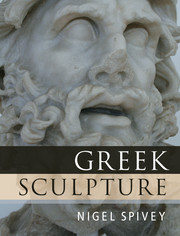Book contents
- Frontmatter
- Dedication
- Contents
- List Of Figures
- Preface
- Note
- 1 Introduction: the Study Of Greek Sculpture
- 2 The Greek Revolution
- 3 Daedalus and the Wings of Technê
- 4 Anathêmata: Gifts for the Gods
- 5 Heroes Apparent
- 6 Temple Stories
- 7 In Search of Pheidias
- 8 Revealing Aphrodite
- 9 Royal Patronage
- 10 Portraits and Personifications
- 11 Graecia Capta
- 12 Afterlife
- Index
8 - Revealing Aphrodite
Published online by Cambridge University Press: 01 December 2014
- Frontmatter
- Dedication
- Contents
- List Of Figures
- Preface
- Note
- 1 Introduction: the Study Of Greek Sculpture
- 2 The Greek Revolution
- 3 Daedalus and the Wings of Technê
- 4 Anathêmata: Gifts for the Gods
- 5 Heroes Apparent
- 6 Temple Stories
- 7 In Search of Pheidias
- 8 Revealing Aphrodite
- 9 Royal Patronage
- 10 Portraits and Personifications
- 11 Graecia Capta
- 12 Afterlife
- Index
Summary
Predominant among the earliest three-dimensional images produced by humankind are statuettes of the unclothed female form. There are variations within examples from around the world, but they share a basic selective emphasis of body-parts: breasts, hips and genitalia. Historically, (male) archaeologists have been unable to resist attributing a sexy function to these Stone Age figures – so the ‘Venus of Willendorf’, the ‘Venus of Malta’ and so on. The Latin name of the goddess has been preferred, but the Greek Aphrodite remains the conceptual source. And Aphrodite was not a ‘fertility goddess’. To associate any image with Aphrodite is to place that image in the realm of the erotic.
What is ‘erotic’? Pedantically, it should be whatever belongs in the realm of eros, which is Greek for ‘love’, and also Eros (Cupid), the winged boy, sometimes armed with bow and arrow, who is Aphrodite's son or messenger. In antiquity, as we shall see, there was scope for recognizing tension between what we would call ‘love’ and what we would call ‘lust’; nonetheless, Greeks and Romans alike were relatively shameless in their acknowledgement of the force of erotic desire. The irresistible, carnal and generative power of Aphrodite/Venus was honoured gleefully. ‘You alone are the guiding power of the universe and without you nothing emerges into the shining sunlit world to grow in joy and loveliness.’ Lucretius, the Latin poet-philosopher who made this unreserved salutation (De Rerum Natura 1.21–3), was writing in a time when his own head of state, the emperor Augustus, claimed descent from the goddess; yet it was not eccentric to recognize Aphrodite's ultimate supremacy: supremacy over most of her fellow Olympians, and supremacy not only over humankind, but also ‘birds that fly in the air and all the many creatures that the dry land rears, and all that the sea’ (Homeric Hymn 5, ‘To Aphrodite’, 1–6).
We do not know how far Stone Age communities shared this respect for the procreative impulse; we only assume, with the ‘Venus of Willendorf’ and others, that incomplete representation significantly isolates those female parts designed for intercourse, childbirth and lactation.
- Type
- Chapter
- Information
- Greek Sculpture , pp. 194 - 215Publisher: Cambridge University PressPrint publication year: 2013

